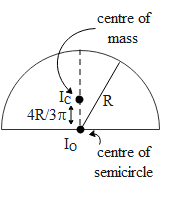
The moment of inertia of a uniform semi circular disc about the axis passing through the centre of mass and perpendicular to its plane is (Mass of the disc is M and radius is R)
$\begin{align}
& a)\dfrac{M{{R}^{2}}}{2}+M{{\left( \dfrac{4R}{3\pi } \right)}^{2}} \\
& b)\dfrac{M{{R}^{2}}}{2}-M{{\left( \dfrac{4R}{3\pi } \right)}^{2}} \\
& c)\dfrac{M{{R}^{2}}}{2}-M{{\left( \dfrac{2R}{\pi } \right)}^{2}} \\
& d)\dfrac{M{{R}^{2}}}{2}+M{{\left( \dfrac{2R}{\pi } \right)}^{2}} \\
\end{align}$
Answer
516.5k+ views
Hint: In the above question we are asked to determine the moment of inertia along the axis perpendicular to the plane through the centre of mass. First we will determine the moment of inertia along the centre of the semicircular disc. Further using the parallel axis theorem of moment of inertia we will determine the moment of inertia along the centre of mass.
Formula used:
${{I}_{\text{SEMI-CIRCLE}}}=\dfrac{{{I}_{\text{CIRCLE}}}}{2}$
${{I}_{CM}}=I-M{{r}^{2}}$
Complete step-by-step answer:
To begin with let us discuss the moment of inertia along the centre of the circle. Let us say the mass of a circular disc is 2M and the radius of the disc be R. Hence the moment of inertia of the circular disc about its centre is ,
${{I}_{CIRCLE}}=\dfrac{2M{{R}^{2}}}{2}=M{{R}^{2}}$
Since the above semicircular disc has a uniform symmetric distribution of mass M, therefore we can say that the moment of inertia of the semicircular disc about its centre will be half of the moment of inertia of the circular disc i.e.
$\begin{align}
& {{I}_{\text{SEMI-CIRCLE}}}=\dfrac{{{I}_{\text{CIRCLE}}}}{2} \\
& \Rightarrow {{I}_{\text{SEMI-CIRCLE}}}=\dfrac{M{{R}^{2}}}{2} \\
\end{align}$

In the above figure we can see that the centre of mass is at a distance of $\dfrac{4R}{3\pi }$ from the centre of the semicircle. Let us denote this distance by r. Let us say that along the centre of the circle the moment of inertia of the disc is ($I$). Therefore the moment of inertia along the centre of mass(${{I}_{CM}}$ ) by parallel axis theorem is given by,
${{I}_{CM}}=I-M{{r}^{2}}$
We know that moment of inertia along the centre of the semicircle is $\dfrac{M{{R}^{2}}}{2}$and the distance from the centre to the point of centre of mass is $\dfrac{4R}{3\pi }$ . Hence from the above equation the moment of inertia along the centre of mass is equal to,
$\begin{align}
& {{I}_{CM}}=I-M{{r}^{2}} \\
& \Rightarrow {{I}_{CM}}=\dfrac{M{{R}^{2}}}{2}-M{{\left( \dfrac{4R}{3\pi } \right)}^{2}} \\
\end{align}$
Hence the correct answer of the above question is option b.
So, the correct answer is “Option b”.
Note: It is to be noted that the above semicircular disc is given to be symmetric. Hence we could say the moment of inertia of the semicircular disc is half to that of the circular disc of the same radius. If we observe the above equation of moment of inertia along the centre of mass, we can conclude that the moment of inertia about the centre of mass is the minimum.
Formula used:
${{I}_{\text{SEMI-CIRCLE}}}=\dfrac{{{I}_{\text{CIRCLE}}}}{2}$
${{I}_{CM}}=I-M{{r}^{2}}$
Complete step-by-step answer:
To begin with let us discuss the moment of inertia along the centre of the circle. Let us say the mass of a circular disc is 2M and the radius of the disc be R. Hence the moment of inertia of the circular disc about its centre is ,
${{I}_{CIRCLE}}=\dfrac{2M{{R}^{2}}}{2}=M{{R}^{2}}$
Since the above semicircular disc has a uniform symmetric distribution of mass M, therefore we can say that the moment of inertia of the semicircular disc about its centre will be half of the moment of inertia of the circular disc i.e.
$\begin{align}
& {{I}_{\text{SEMI-CIRCLE}}}=\dfrac{{{I}_{\text{CIRCLE}}}}{2} \\
& \Rightarrow {{I}_{\text{SEMI-CIRCLE}}}=\dfrac{M{{R}^{2}}}{2} \\
\end{align}$

In the above figure we can see that the centre of mass is at a distance of $\dfrac{4R}{3\pi }$ from the centre of the semicircle. Let us denote this distance by r. Let us say that along the centre of the circle the moment of inertia of the disc is ($I$). Therefore the moment of inertia along the centre of mass(${{I}_{CM}}$ ) by parallel axis theorem is given by,
${{I}_{CM}}=I-M{{r}^{2}}$
We know that moment of inertia along the centre of the semicircle is $\dfrac{M{{R}^{2}}}{2}$and the distance from the centre to the point of centre of mass is $\dfrac{4R}{3\pi }$ . Hence from the above equation the moment of inertia along the centre of mass is equal to,
$\begin{align}
& {{I}_{CM}}=I-M{{r}^{2}} \\
& \Rightarrow {{I}_{CM}}=\dfrac{M{{R}^{2}}}{2}-M{{\left( \dfrac{4R}{3\pi } \right)}^{2}} \\
\end{align}$
Hence the correct answer of the above question is option b.
So, the correct answer is “Option b”.
Note: It is to be noted that the above semicircular disc is given to be symmetric. Hence we could say the moment of inertia of the semicircular disc is half to that of the circular disc of the same radius. If we observe the above equation of moment of inertia along the centre of mass, we can conclude that the moment of inertia about the centre of mass is the minimum.
Recently Updated Pages
Master Class 11 Economics: Engaging Questions & Answers for Success

Master Class 11 English: Engaging Questions & Answers for Success

Master Class 11 Social Science: Engaging Questions & Answers for Success

Master Class 11 Biology: Engaging Questions & Answers for Success

Class 11 Question and Answer - Your Ultimate Solutions Guide

Master Class 11 Business Studies: Engaging Questions & Answers for Success

Trending doubts
What is meant by exothermic and endothermic reactions class 11 chemistry CBSE

10 examples of friction in our daily life

One Metric ton is equal to kg A 10000 B 1000 C 100 class 11 physics CBSE

Difference Between Prokaryotic Cells and Eukaryotic Cells

What are Quantum numbers Explain the quantum number class 11 chemistry CBSE

1 Quintal is equal to a 110 kg b 10 kg c 100kg d 1000 class 11 physics CBSE




